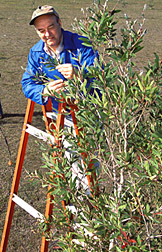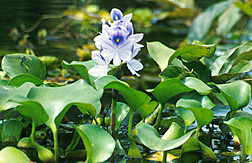This page has been archived and is being provided for reference purposes only. The page is no longer being updated, and therefore, links on the page may be invalid.
New Textbook is Important Weed Biocontrol Tool
By Alfredo FloresJuly 9, 2008
An Agricultural Research Service (ARS) expert on invasive weeds like water hyacinth and melaleuca has co-authored a new textbook to help university students and others learn about biological control and other strategies for controlling weeds.
The new textbook, "Control of Pests and Weeds by Natural Enemies: An Introduction to Biological Control," was co-authored by Ted Center, director of the ARS Invasive Plant Research Laboratory (IPRL) in Fort Lauderdale, Fla.
Water hyacinth has infested waters in many tropical and subtropical parts of the Americas, Asia, Australia and Africa. It clogs up the waterways and hampers boating and fishing, water supply, flood control, mosquito control, fisheries and wildlife management, as well as damaging irrigation systems used to grow food.
Center has had success with hyacinth-eating biological control insects from South America. These insects have been effective complements to chemical control methods, because they go where sprays can't reach. He is now searching for other prospective biological controls, which must go through quarantine at IPRL and be carefully tested--to make sure they eat only the right weeds--before they may be released into the environment.
Center and his colleagues are also fighting melaleuca, a fast-spreading invasive Australian tree that's threatening survival of the Florida Everglades, the largest subtropical wilderness in the United States.
The new textbook, published by Blackwell Publishing Ltd., includes water hyacinth and many other invasive weeds--both aquatic and terrestrial--detailing their history, attributes, and methods to eliminate or control them. It is a valuable reference book for biocontrol professionals, agriculturalists, wildlife biologists and others.
Co-authoring the book with Center are the book's lead author, Roy G. Van Driesche of the University of Massachusetts-Amherst, and Mark S. Hoddle of the University of California-Riverside. Van Driesche and Hoddle wrote the chapters pertaining to insect biological control, while Center wrote the chapters dealing specifically with weed biological control. All three authors contributed to chapters relating to themes common to both insects and weeds.
ARS is a scientific research agency of the U.S. Department of Agriculture.


